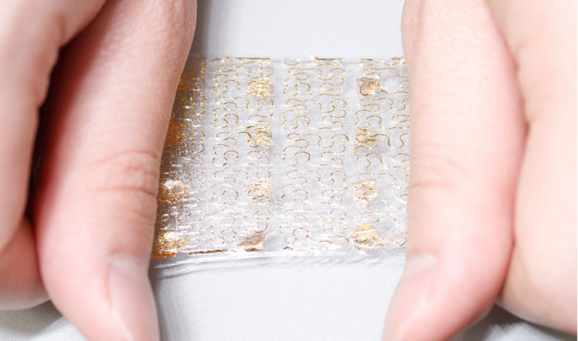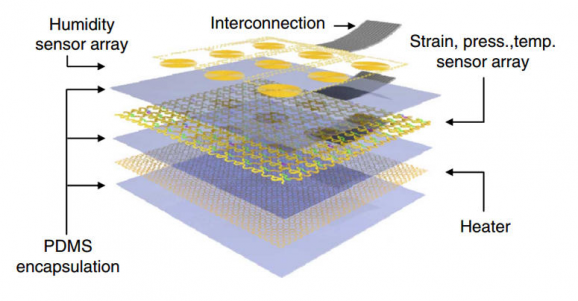This Smart Skin Feels Pressure And Even Heat
This article is more than 2 years old
 Some prosthetics make no attempt to emulate actual skin—there are a number that boast a futuristic and robotic appearance, such as some myoelectric and bionic devices. But if you look at sci-fi characters like Alien’s Bishop and Star Trek TNG’s Data, it’s tough to tell them from humans (at least, until they act with such decency that they can’t possibly be real people). Part of that is their skin, which, in the case of human lookalike androids like the Philip K. Dick bot, is referred to as “frubber.” While this artificial skin looks more and more like human skin, the big difference has been its lack of sensation. I could burn the Philip K. Dick android with a cattle prod, for example (I never would, mind you—that thing is awesome) and it wouldn’t feel a thing. But that’s changing. Researchers at Seoul National University have developed a prosthetic skin that can feel.
Some prosthetics make no attempt to emulate actual skin—there are a number that boast a futuristic and robotic appearance, such as some myoelectric and bionic devices. But if you look at sci-fi characters like Alien’s Bishop and Star Trek TNG’s Data, it’s tough to tell them from humans (at least, until they act with such decency that they can’t possibly be real people). Part of that is their skin, which, in the case of human lookalike androids like the Philip K. Dick bot, is referred to as “frubber.” While this artificial skin looks more and more like human skin, the big difference has been its lack of sensation. I could burn the Philip K. Dick android with a cattle prod, for example (I never would, mind you—that thing is awesome) and it wouldn’t feel a thing. But that’s changing. Researchers at Seoul National University have developed a prosthetic skin that can feel.
 Advancements in prosthetic limbs include sensors, which allow people to adjust the amount of pressure they exert. Such sensors allow people with prosthetic hands to grip a softball with more force than they’d grip an egg, for example. If you can’t feel, you can’t know how much pressure you’re exerting, which could be messy and problematic. The Seoul research team, who recently published their findings in Nature Communications, has gone beyond those types of sensors to create “smart” skin with much more sensitive sensors embedded with crystalline silicone nanoribbon.
Advancements in prosthetic limbs include sensors, which allow people to adjust the amount of pressure they exert. Such sensors allow people with prosthetic hands to grip a softball with more force than they’d grip an egg, for example. If you can’t feel, you can’t know how much pressure you’re exerting, which could be messy and problematic. The Seoul research team, who recently published their findings in Nature Communications, has gone beyond those types of sensors to create “smart” skin with much more sensitive sensors embedded with crystalline silicone nanoribbon.
In addition to being able to feel pressure, the newly developed sensors also detect temperature, humidity, and strain. They have arrays comprised of stretchable electrodes that facilitate nerve stimulation and provide heat. All of these features allow this to behave more like normal skin. You can sense whether a pan was hot, or even whether someone’s forehead was warmer than usual. The embedded heaters allow the skin to feel more real to others who might touch it—a nice feature, given that it must be kind of strange to hold hands with someone with cold plastic fingers.
 The strain sensors indicate how much the skin is stretching and whether it’s nearing fatigue. Human skin does this too, so the team studied what happens to a real hand as it performs complex movements, and then mapped similar effects onto the nanoribbon sensors. According to the study, “The prosthetic hand and laminated electronic skin could encounter many complex operations such as hand shaking, keyboard tapping, ball grasping, holding a cup of hot/cold drink, touching dry/wet surfaces and human to human contact.”
The strain sensors indicate how much the skin is stretching and whether it’s nearing fatigue. Human skin does this too, so the team studied what happens to a real hand as it performs complex movements, and then mapped similar effects onto the nanoribbon sensors. According to the study, “The prosthetic hand and laminated electronic skin could encounter many complex operations such as hand shaking, keyboard tapping, ball grasping, holding a cup of hot/cold drink, touching dry/wet surfaces and human to human contact.”
The sensors are distributed in thin layers, which makes the skin more durable. The electrodes communicate with the wearer’s nerves via platinum nanowires and ceria nanoparticles, enhancing the connection while minimizing discomfort and inflammation. The researchers believe that their skin will make major contributions to the “emerging field of smart prosthetics.”












